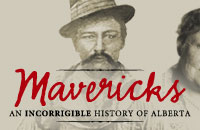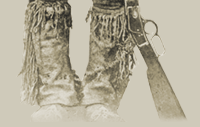 |

[ Project Plans | Essential
Questions | Knowledge Hunt | Glossary | Links ]
Settin' Up A "Brand" New Ranch
Understanding the Early Alberta Ranching Life through the Creation
of a Simulated Ranch
Introduction
Students need to understand how in the 1880s ranching began to
populate the land that is now Alberta. They will explore how the
geographic, cultural, economic and historical characteristics of
the times are reflected in our interaction with the land now. What
factors led to the "Era of the Big Ranches"? What geographic
factors were important to their setup? What costs were involved?
Where did the men and cattle come from? What problems would a ranch
manager have to overcome in order to make the ranch successful?
Project Explanation
In this project, students will develop an appreciation of the lifestyle,
history and development of the early Alberta ranching sector. Students
will learn geographic and mapping skills, use historical thinking,
apply mathematical problem solving using concepts of area and perimeter,
and determine how the Era of the Big Ranches shaped the evolution
of Alberta. Students will create their own simulated ranch using
historical details by mapping and determining the area they will
lease from the government, plan the buildings that would be needed,
examine the amount of natural resources, cattle, and men needed
to run the operation, brainstorm possible problems that might arise
and create a plan to deal with them, and research the factors that
led to changes the way ranching took place in Alberta.
Alberta Social Studies Curriculum Unit Connections
Grade Four - Alberta: The Land, Histories and Stories
4.1 Alberta: A Sense of the Land
4.2 The Stories, Histories and People of Alberta
Grade Five - Canada: The Land, Histories and Stories
5.1 Physical Geography of Canada
5.2 Histories and Stories of Ways of Life in Canada
Materials and Resources Needed
Procedures
Students will create their own simulated ranch using historical
details from the 1880's era ranches. It would be recommended that
they work in small groups in order to allow for brainstorming, consensus
building, and more people to do the work.
Introduce the project to the students by telling them that they
will be acting as the ranch manager for a group of wealthy investors
back in Eastern Canada. In 1881, Sir John A. Macdonald's government
passed an Order-in-Council permitting land leases all the way up
to 10 000 acres at the rate of one cent ($0.01) per acre per year.
The rush was on for investors and land promoters!
Create student groups and have students begin by deciding upon
a name for the ranch and designing a brand that represents the group
members in some manner. They can research about the history of applying
brands and examine how ranchers came up with brand designs. After
creating the brand and naming their ranches, the brands can be shared
with the other groups, challenging them to try to "read"
the ranch name from the brand.
The students will then begin researching what ranching was like
in the 1880's using the ranching content area in Mavericks:
An Incorrigible History of Alberta. This will provide a general
understanding of what might be needed as they work through setting
up their ranch. As a whole class, students will brainstorm questions
they will have to answer in order complete the project. For example,
how big is an acre, what did cattle cost then, how much were cowboys
paid, what problems must we overcome, and so on. They can search
"ranch" on the Images Canada web site for ranch
pictures so that they may get an idea of what a ranch might have
looked like and what buildings and structures will be needed.
The groups will then work together, using either printed maps of
Alberta or online maps from Mavericks: An Incorrigible History
of Alberta to decide where a good place to settle would be and
how many acres will they lease from the Federal Government. The
geography of the area is a major factor in the settlement of any
region. The investors back east will need a report for the group
with a geographic and climatic description of the area including
information about the general climate, weather, landforms, flora
and fauna, soil conditions, and water sources. Students should also
think about the chosen area's effect on transportation, communication,
and the raising of the animals themselves.
The investors also will need the ranch managers to create a map
of the ranch itself. It will need a title, legend, scale, cardinal
directions, water sources, geographic landmarks such as sloughs,
cliffs, trails, etc. Students may also choose to add contour lines
denoting elevation of hills and valleys. The area they have chosen
should be clearly labeled, as well as any buildings or fences that
will have to be built. They may then calculate the area of the land
and determine the perimeter of any fencing they use for the ranch.
The ranch managers will then have to prepare a budget for the coming
year to present to the investors. The ranch managers will examine
the amount of cattle and men needed for a successful operation.
Below are some of the stipulations they will need to follow:
- During the late 1800s cowboys worked from dawn until dusk for
$10 to $30 a month (depending on experience) with food and a bunkhouse
supplied
- Dominion Lands Policy – there must be one cow for every
10 acres under lease
- The cost of cattle is 7 cents ($0.07) per pound
- The size of the cattle bought averages to about 900 pounds per
head
Students may also determine any other costs that might be likely,
such as the cost of food, a cook, horses, saddles, wood and building
costs, etc.
The team, having done some research on cattle operations at the
time, will then brainstorm possible problems that might arise. These
could include moving the cattle across geographic barriers such
as rivers and mountains, falling cattle prices, end of the lease
agreement, a terrible drought, heavy winter snowstorms, disease
killing cattle, rounding up cattle in the spring, etc. For each
major problem, they should create a plan for what they will do in
case that difficulty arises.
Using the Mavericks: An Incorrigible History of Alberta
site, students will research the factors that led to ranches having
to modify and adapt how they did business. Some of the main reasons
were the end of land lease agreements, the end of the open range
due to settlers coming west, falling cattle prices, and the terrible
winter of 1906-07.
The groups of ranch managers may share their projects with the
rest of the class in a presentation format, or specific parts may
be examined as a large group in order to share and compare what
each different group came up with. Another option would be to invite
some local ranchers to attend and allow students to share their
projects with these experts.
Assessment and Evaluation
- Students and their teacher should develop their own rubric by
identifying evaluation criteria for the project that will match
their own learner outcomes. This allows students to understand
the expectations for their work and to have input into the ongoing
evaluation process.
- Students may use their rubric as a guide for writing a self-assessment
of their project work. They will determine their level for each
of the categories and use the criteria specified in their rubric
to justify them.
- A project journal may be used for information gathering as well
as for reflective writing as the process is taking place. Students
can pose questions, vent frustrations, synthesize their work,
examine their process, and even wonder about what they are missing
or what is still needed for their project. This may be completed
as a group or individually.
Ideas for Enriching this Project
- Students could research and compare an 1880's ranch to
a modern ranch. Factors such as size of the land, number of head
of cattle, the methods they use for raising healthy animals, costs
of animals and beef prices, tools and machinery used, etc.
- The class could end the project by investigating the Beef Cattle
Industry in Alberta and Canada today. Using the Canada's
Beef Cattle Industry Fact Sheet PDF, they can gain a simple understanding
of how the industry has developed over the past 100 years.
 |



![]()
